|
EQUINE CLICKER TRAINING..... using precision and positive reinforcement to teach horses and people |
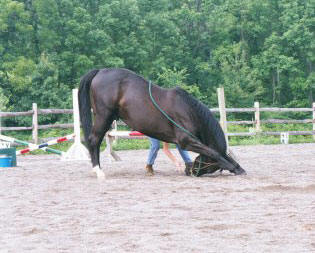
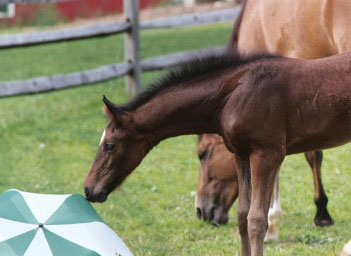
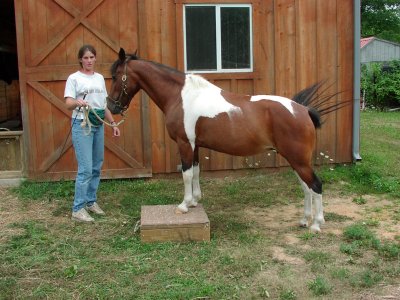
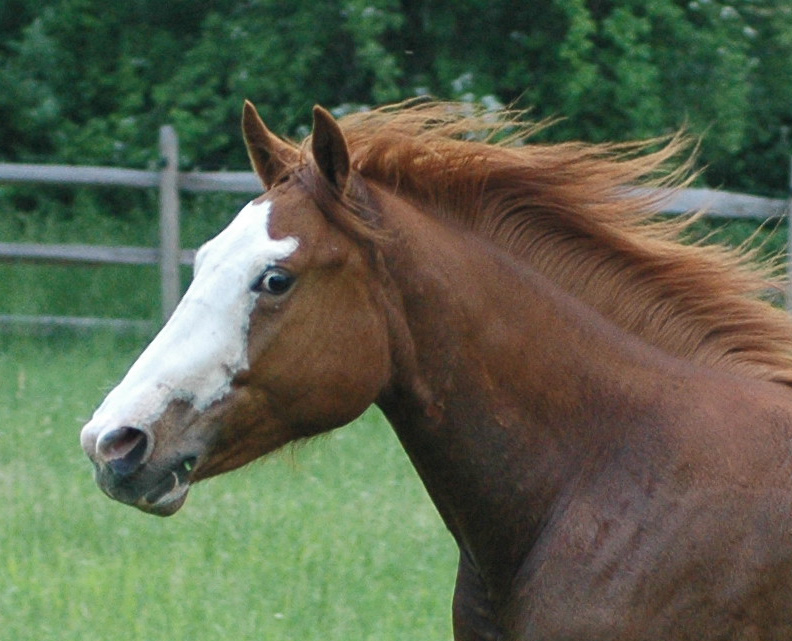
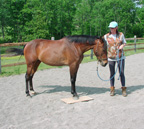
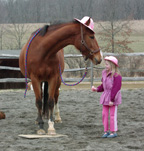

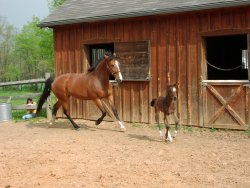 |
|
Putting our heads together, and what can come of it...
Everyone loves horse heads.
The horse head must be the most photographed part of the horse. We love
their big soft eyes, their flowing forelocks, the curve of their neck.
Think of all those little girls in math class doodling on their pages. What
do they draw? legs, backs, tails, no..it is always the head..rows and rows
of horse heads. If you talk to a number of horse people, they will all
have an opinion on horse heads. I was taught that horses don't actually like
you to touch their head, they prefer their neck. I have met people who think
they like to be rubbed up between their eyes, others rub around their eyes
or nostrils. Everyone seems to have an opinion and everyone seems to
want to touch their horse's heads.
I don't know what got me
thinking about horse heads. Maybe it was an ongoing frustration with Willy
who still has nippy days. Maybe it was a lot of reading I had been doing.
But suddenly it seemed to me that horse's heads are really important, and
not just because they are beautiful. They are an important piece of the work
that I am trying to understand with my own horses. I have horses with
physical and mental issues, and then I have just plain green horses that are
learning how to work with people, bridles and lead ropes for the first time.
A lot of early work with green horses involves teaching the horse what to do
by controlling his head.
But what do the horses
think of this? Do you think most horses enjoy having their faces
touched? How well do you really know your own horse? There are some
horses that will bring their heads up to you and rub
you, or nudge you. Are they looking for food or attention? It's hard to say.
Others are decidedly head shy and don't want you anywhere near their heads.
My yearling didn't want his head handled at all as a foal, and I understand
that this is typical. Foals are very protective of their heads and since most of
them learn haltering and leading skills as their first formal interactions
with people, these early lessons can set up the pattern for
later life. But even with my foal who was haltered very gently, we had to
work through a lot of head and mouth issues. Since I already had some
horses with issues involving their heads, I started to think about horse's heads
beyond the basic handling.
My first clues that it
might be worth spending more time with my horses' heads was when I noticed that a lot of trainers have one
or more exercises that involve manipulating the horse's head. Some are
just meant to desensitize the horse to your touch, others are meant to
actively manipulate a horse that is holding tension in his jaw or poll. Some
exercises use the head and neck to access the rest of the spine and body.
I recently read about a series
of exercises that Peggy Cummings does with horse's heads. Bettina Drummond
shows how she uses contact with a young horse's head to help her settle
down in her videos. She places a hand on the bridge of the nose to back the
horse up and get it to release its back. Linda Tellington-Jones
also spends time on horse's heads. With all these exercises available,
I decided that it was worth spending some time working with my own horse's
heads. I had done some work previously, but mostly it was limited to
teaching the horse to accept my touch and that biting me was not acceptable.
When Willy came to me 10
years ago, he was just
generally grouchy. He came to me after a racing career and then passing fairly quickly through
several other owners. He was very suspicious of another new owner. He
didn't particularly like being touched on his head, although he would
tolerate it. He also hated pressure on the lead rope, which showed itself by
his unwillingness to be tied. If he was tied up, he would set his weight
back and just lean until something broke. If I was leading him and put
a lot of pressure on the line, he would fly back. Over time, and with
some re-schooling, he learned to tolerate having his head handled and I
learned that he had quite a fondness for head games, as long as he
instigated them. He loves to use his lips and mouth and is very careful and
deliberate. I have many times seen him take his teeth and hold someone's
watch in his mouth (yes, while it is still on their wrist). This is not
something I ever encouraged, but other people seem to think it is funny. I
have seen him take someone's jacket collar in his teeth and hold it. He did
try this once with me and I made him let go. That was a little too
close for my comfort.
Anyways, the point of this
is that while he had his own head games that he liked, he was not truly
comfortable having me in his space, especially around his head. He was no more comfortable with me
being near his head, than I was having him near my head. For years, we just
watched out for each other, and I was certainly able to perform all the
routine horse care that he required. But recently as I started to think
more about the importance of how we handle horse's heads, I realized I
wanted him to be very comfortable with me all
over his head. This started when I learned that I could use his
reaction to my proximity to his head as a clue to his state of mind. I had
noticed long ago that on some days, he would be a bit nippy. I originally
just put this down to high spirits, but as time progressed, I realized that
he was nippy on days when it was cold, windy etc.. He seemed to be nippy on
days when he was nervous or not as comfortable in his body. So I started
using the nippiness as another way to evaluate his mood. And while I can respect
Willy's wishes for me to leave his head alone, I decided that in
the long run it is better for him to learn that a touch on the head is
no different than a touch anywhere else, and that he can trust me to come
into his space and help him through direct physical contact. In the
beginning, he was clearly unhappy with the whole business, but I have to say
that he has become very accepting now. And he has become a lot less
nippy. Maybe it is just because he is more used to my hands being near his head
and has become desensitized. But what I have decided is that it doesn't matter. If you are
going to lead and ride a horse, you want him to be really comfortable with
you around his head. You are going to attach reins and leads to his head, and
while they are less of a direct connection than touching the head with your
hands, you want them to be welcomed
too. I spent weeks working on teaching him that every time I touched
his head, it meant something, and there was a possibility for reinforcement
if he just listened to what I was asking. I then went on and did this
with my other horses too. Since I keep my horses at home, I have many
chances to interact with them and I tried to spend as much time touching
their heads as I could. I would rub their ears, rub under their jowls,
stroke their faces, lead them by their chins, move them around their stalls
by a hand on the head. Any time I could, I used their head to direct them.
And they got happier about it. With a soft touch, I could direct them
anywhere.
I think some of this idea
for training came from work I had done with both my young colt and with my
mini. When my mini came to me, he had a biting problem. He had been cared
for by a woman in a wheelchair and they played a lot of mouth games since
she was limited in what she could do. With small children, I didn't
want him biting at anyone and I used clicker training to teach him to hold
his head and lips still when someone's hand was nearby. I got to the
point where I could hold my hand next to his mouth and he would hold his lips
very still. I also worked on the idea of being able to put my hands on his
chin and just hold his head steady by cupping his chin. This
idea of "stationing" came from work with other animals where the animals are
taught to rest their heads in the trainer's hand as a way of marking the
location or position that the trainer desires. So, rather than just having a
horse that allows you to hold his halter to steady him, I wanted a horse
that would rest his head in my hand so that my other hand could do something
else. This has already been useful for looking at eyes, applying medication
etc.. Somehow when the horse is concentrating on keeping his chin in
your hand, he is much stiller than when you are just holding on to him.
My young colt also liked to
explore things with his mouth, as is typical of horses this age. But with
two horses in my barn who had come with nipping and mouthiness problems, I
was determined that he would not be like that. My first goal was to teach
him to allow me to touch his head without biting at me. I found that
pressure and release was not enough to communicate this to him, as it was too
easy for him to turn it into a game. So I waited until he would eat treats
(grain or carrots) before teaching him. Then I spent hours (in tiny
intervals) teaching him that I could put my hand anywhere on his head and he
needed to just hold still and keep his mouth quiet. In the beginning, it was
quite a challenge as young horses do love to play with their mouths and
explore everything. But over time he improved to the point that I could hold
my hand under his nose and he would not even try to nibble at it, or look
for a treat if I hadn't clicked. Visitors are always surprised that he does
not lick them, or look for a treat. I have to confess that I am surprised at
how many people go up to a strange horse and offer their hand. Plenty of
horses like to lick hands, but plenty of horses also like to take a nibble
here and there too.
Since then I have continued
my work on Willy's head. Most recently I have started working him with one
hand on his halter and the other on his shoulder, using my feel on the
halter and sometimes my hand directly on his face to communicate what I
want. I use this position when we are working on liberty work in the round
pen and I am trying to adjust his position or direct him. It is a very different feeling that working with a lead. With a lead,
if he is in a nippy mood, I try to be lighter and stay out of his space and
if he is feeling tense, he might bite at me every now and then. This usually
improves as the session goes on, but I really wanted to figure out why he
felt so threatened and come up with a way to help him work through it.
With that in mind, I started working directly on his head. I had originally started
by holding the halter so that I was less likely
to get bitten and so I could really feel what he was doing with his head and
neck. Then I decided that I rather liked having my hand directly on his
head. I could really feel when he started to get tense and when he was soft
and accepting. I do have to be careful about
holding him if he gets upset, as I don't want either of us to get injured or
set up a situation where he thinks he can just blast through and I will let
go, so I usually have the lead looped around his neck too. But most days he seems to eventually settle and allow me to
manipulate his head and neck with my hands. In this way, I can use the head
handling exercises as both a way to get him to relax and accept my touch,
and also as an indicator of how his body is feeling that day.
Rosie was a different
story. When Rosie came, she was not comfortable with people at all. She
would not come up to you, or if she did, it was with teeth bared and ears
back. When I handled her, I was very respectful of her space and didn't push
her beyond her comfort level. That's not to say that I let her do whatever
she wanted, but if she didn't want to be touched somewhere, I left it alone
for a while. I didn't feel like I had a positive enough relationship with
her to tackle some things, and they were not crucial to her daily well being,
so we left them alone. Once I had caught her, she was actually ok with
her head, but she certainly didn't seem to like it. And because she had some
aggressive tendencies, I spent a long time teaching her to stay out of my
space and to keep her head away from me. Back then I was worried about
mugging behavior so I was really strict about not letting her put her head
too close to mine. We worked along okay for a while and then one summer I
realized that since I had reinforced her so much for staying out of my
space, she was not comfortable being in my space, even when I invited her
in.
So this started a whole new series of exercises. I had to teach her that
it was ok to come up to me and I could pat her head and ask her to come
closer. It was pretty clear that she was nervous when she was too
close, as if she thought she was doing something wrong. So then I
started reinforcing her for letting me touch her and move her head around. I
reinforced her for coming politely into my space. There is a fine line here.
I found with all my horses that there is a very narrow margin between a
pushy and in-your-face horse and a friendly and affectionate horse.
Not only that, what I consider appropriate might not be the same for someone
else or with a different horse. With clicker training, I find it easy
to communicate with the horse so they know what is allowed and what is not,
and I can do this without getting negative. I think it's so important not to
be negative with a horse's head. Not just because a horse who is head
shy or ear shy is difficult, but because I think that if they give you their
head with total softness and trust, then that is the key to being able to
get to everything else.
And last but not least,
spend some time just stroking your horse's head with love. Sometimes
when I was doing these head handling exercises, I got caught up in treating
the head as just any other body part and that was fine. But I found that it
was nice to take a quiet moment and really just enjoy spending time with my
horse. I would gently rub those favorite spots and tell my horse just
how special he was and how much I enjoyed spending time with there with him.
And, you know what? They look like they enjoy it too. Rosie now drops
her head and relaxes her eyes and I can just feel her giving a big sigh of
relief. And I give a big sigh of relief too because it's so nice to
know that we can share this peaceful moment together and that she enjoys it
as much as I do.
Home | Articles | Clicker Basics | Community | FAQ | Getting Started | Horse Stories | Links | Photos | Resources
|
||||